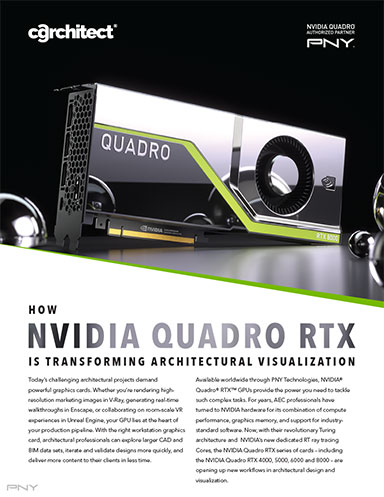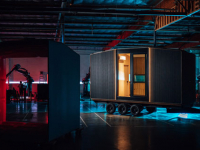How NVIDIA QUADRO RTX is Transforming Architectural Visualization
Through their Turing architecture, NVIDIA Quadro RTX GPUs are changing the way that architectural professionals work.

March 17, 2020
Today's challenging architectural projects demand powerful graphics cards. Whether you’re rendering high-resolution marketing images in V-Ray, generating real-time walkthroughs in Enscape, or collaborating on room-scale VR experiences in Unreal Engine, your GPU lies at the heart of your production pipeline.
With the right workstation graphics card, architectural professionals can explore larger CAD and BIM data sets, iterate and validate designs more quickly, and deliver more content to their clients in less time.
Available worldwide through PNY Technologies, NVIDIA® Quadro® RTX™ GPUs provide the power you need to tackle such complex tasks. For years, AEC professionals have turned to NVIDIA hardware for its combination of compute performance, graphics memory, and support for industry-standard software.
Now, with their revolutionary Turing architecture and NVIDIA’s new dedicated RT ray tracing Cores, the NVIDIA Quadro RTX series of cards – including the NVIDIA Quadro RTX 4000, 5000, 6000 and 8000 – are opening up new workflows in architectural design and visualization.
KEY NVIDIA QUADRO RTX BENEFITS: SHARED GPU MEMORY, AI ACCELERATION AND REAL-TIME RAY TRACING
The Turing architecture has several features that benefit graphically intensive tasks. One is the second generation of NVLink, NVIDIA’s high-speed GPU interconnection technology.
With 48GB of error-correcting GDDR6 RAM, the NVIDIA Quadro RTX 8000 has more on-board graphics memory than any other commercially available workstation card. NVLink further enables users to split scene data across two GPUs, creating a potential pool of 96GB of shared memory: enough to fit even the largest architectural scene into the frame buffer during GPU rendering.
Fill out the information below to download the resource.
Latest News









